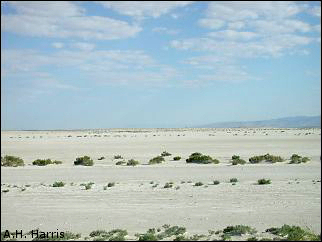
People from outside of our desert often perceive of it as a barren wasteland. Those of us who live here, though, know that out there lies a great diversity of plant and animal life, best viewed up close and personal. But few of us realize that the flowering plants—the angiosperms—that dominate the temperate and tropical regions today are recent upstarts, geologically speaking. Recent fossils from China represent the earliest known representatives of this great group, dating back perhaps only 125 million years or, at most, to slightly older than 140 million years.
Now visualize the desert from the slopes of one of our desert
mountains. Then mentally start stripping away the flowering plants. Gone are the
creosotebushes, the mesquites, the scores of grasses, the cottonwoods and willows. Gone
are the acacias, tarbushes, ocotillos, and cacti. Left are only a few horsetails where
water stands and a few ferns and lichens near the junipers on the mountainside. In
fact, you soon are faced with what the visitor from the outside world wrongly thinks
the desert is—a barren wasteland.
![]()
Contributor: Arthur H. Harris, Laboratory for Environmental Biology, Centennial Museum, University of Texas at El Paso.
Desert Diary is a joint production of the Centennial Museum and KTEP National Public Radio at the University of Texas at El Paso.

Salt Flats, NM. All the plants visible here are angiosperms. If you mentally erase these, you'll have a pretty good idea of what most of the Chihuahuan Desert would look like if there were no angiosperms. Photograph by A.H. Harris.
Sun, G., Q. Ji, D. L. Dilcher, S. Zhen, K. C. Nixon, and X. Wang. 2002. Archaefructaceae, a new basal angiosperm family. Science, 296:899-904.